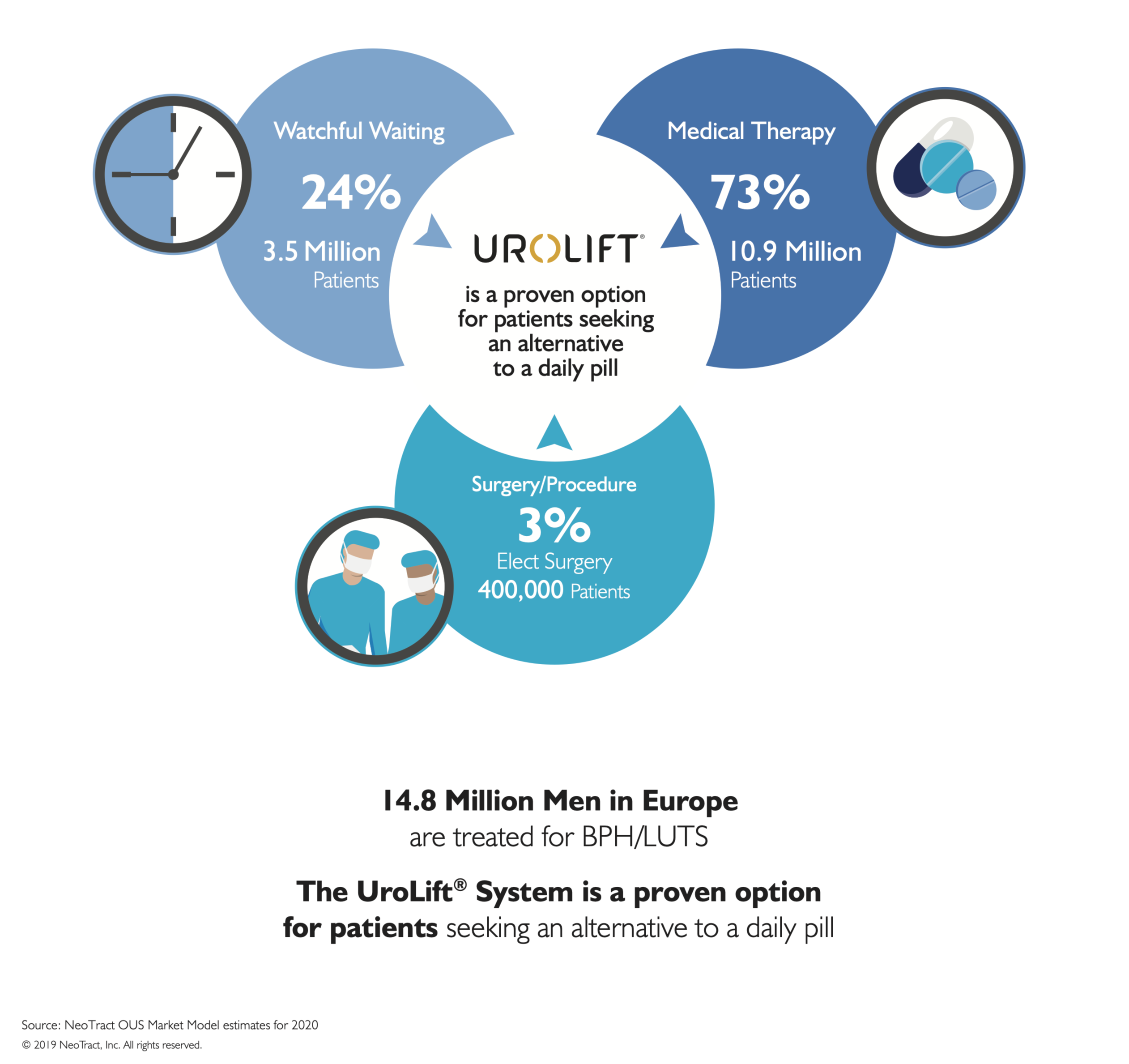Le informazioni nell’area “Per Medici” del nostro sito internet sono destinate esclusivamente ai Professionisti Sanitari.
Apponendo la spunta nel riquadro sottostante, confermi di essere un Professionista Sanitario.

“L’elenco di pubblicazioni cliniche sul sistema UroLift è impeccabile. Ogni paziente trattato nel quadro di un protocollo clinico figura in almeno una pubblicazione sottoposta a peer-review. Gli esiti presentati in numerosi studi sono coerenti, dimostrando un sollievo rapido entro due settimane e un miglioramento prolungato della sintomatologia, della qualità di vita e del flusso urinario”.
- Claus Roehrborn, MD
Risultati clinici presentati in oltre 28 pubblicazioni sottoposte a peer-review dimostrano che il trattamento con il sistema UroLift offre miglioramenti rapidi e significativi dei sintomi, del flusso urinario e della qualità della vita nel corso di almeno cinque anni.1 In confronto alle terapie farmacologiche, il sistema UroLift ha dimostrato un effetto molto più positivo sulla qualità della vita dei pazienti.1 Il trattamento con il sistema UroLift preserva la funzionalità sessuale e previene le complicazioni in genere associate ad altre procedure per l’IPB.1,2,4,21*
La maggior parte dei pazienti vive con la necessità di assumere farmaci soggetti a prescrizione medica per l’IPB, ma questi possono diventare un peso per tutta la vita. In una recente indagine condotta fra uomini, due pazienti su tre hanno riferito frustrazione in merito alla terapia farmacologica per l’IPB.7 Questi pazienti sono riluttanti a considerare una procedura chirurgica a causa dei rischi temuti e dell’invasività delle opzioni standard.
Ora, gli urologi possono offrire il trattamento con il sistema UroLift – una soluzione per l’IPB che migliora la qualità della vita dei pazienti con un rischio minimo.

I pazienti che assumono farmaci per l’IPB non sono soddisfatti
La scelta dell’intervento chirurgico è una decisione importante per i pazienti
Anche la vigile attesa comporta rischi
In un’indagine condotta fra 13.618 uomini di 40-80 anni di età in 29 paesi del mondo, il 23,8%-74,6% ha considerato il rapporto sessuale “da molto a estremamente importante”.18 La disfunzione erettile contribuisce all’insorgere di ansia, depressione, perdita dell’autostima e a una riduzione della qualità della vita, per cui la preservazione della funzionalità erettile influisce significativamente sulla qualità della vita dei pazienti con IPB.19 Nella scelta di un trattamento per l’IPB, è importante tenere presente l’impatto della disfunzione eiaculatoria e di una riduzione della funzionalità sessuale sulla soddisfazione del paziente.
*Nessun caso di disfunzione erettile o eiaculatoria nuova o persistente

Il miglioramento dei sintomi delle basse vie urinarie (LUTS), come indicato dalla riduzione media dell’IPSS (International Prostate Symptom Score), è coerente fra i vari studi, mostrando un sollievo rapido entro due settimane e un effetto prolungato in un periodo di cinque anni.1 Il miglioramento dell’IPSS dopo un anno è superiore a quello ottenuto con i farmaci.2,4
Anche la qualità della vita (QOL) è migliorata significativamente, con miglioramenti dell’IPSS relativo alla QOL e dell’indice di impatto dell’IPB mantenutisi, rispettivamente, al 50% e al 52% in un periodo di cinque anni, p<0,0001.1
Oltre al miglioramento dei LUTS, il trattamento con il sistema UroLift ha dimostrato un notevole miglioramento medio della portata massima del flusso urinario (Qmax) pari a 3,5 ml/s (44%) sostenuta in un periodo di cinque anni, p<0,0001.1
La percentuale di interventi chirurgici successivi con il sistema UroLift necessari a causa dell’esito negativo della procedura per l’IPB rimane bassa, con circa il 13,6% nel corso di cinque anni ossia circa 2-3% all’anno.1 Nello studio cardine sul sistema UroLift, durante il primo anno postoperatorio non si è reso necessario alcun ulteriore intervento chirurgico per rimediare a una contrattura del collo della vescica, sanguinamento o incontinenza da stress.4


Pubblicazione
Roehrborn, et al.The Prostatic Urethral Lift for the Treatment of Lower Urinary Tract Symptoms Associated with Prostate Enlargement Due to Benign Prostatic Hyperplasia: The L.I.F.T. Study 2013.

Pubblicazione
Roehrborn, et al. Five year results of the prospective randomized controlled prostatic urethral L.I.F.T. study. Canadian Journal of Urology 2017.
Fonti
*Nessun caso di nuova e prolungata disfunzione erettile o eiaculatoria nello studio pivotal LIFT
Indicato per il trattamento dei sintomi dell'ingrossamento della prostata fino a 100 cc negli uomini di età pari o superiore a 45 anni. Come per qualsiasi procedura medica, i risultati individuali possono variare. Gli effetti collaterali più comuni sono temporanei e comprendono ematuria, disuria, urgenza minzionale, dolore pelvico e incontinenza da urgenza (Roehrborn, J Urology 2013). Effetti collaterali rari, tra cui sanguinamento e infezione, possono portare a conseguenze gravi e richiedere un intervento chirurgico. Per ulteriori informazioni, consultare le istruzioni per l'uso (IFU).
Controindicato negli uomini con ematuria macroscopica in corso, infezione delle vie urinarie, incontinenza urinaria, patologie uretrali che impediscono l'inserimento del dispositivo o volume prostatico superiore a 100 cc.
Teleflex, il logo Teleflex, UroLift, il logo UroLift, BPH Advisor, MyBPH Report e UroLift ATC sono marchi commerciali o marchi registrati di Teleflex Incorporated o delle sue affiliate negli Stati Uniti e/o in altri paesi.
© 2025 Teleflex Inc. Tutti i diritti riservati. | Termini di utilizzo | Informativa sulla privacy in Internet | Sicurezza del paziente | Crediti | Compliance
MAC01358-08 Rev A